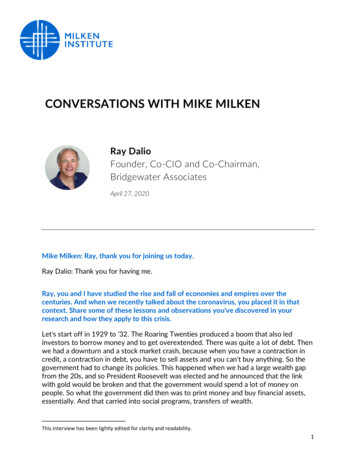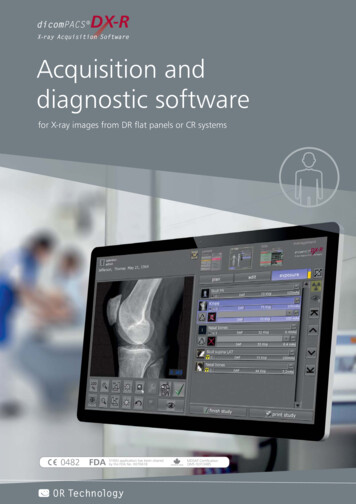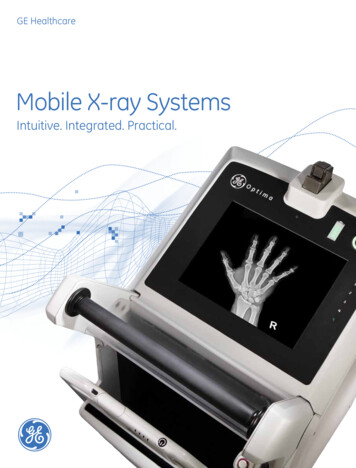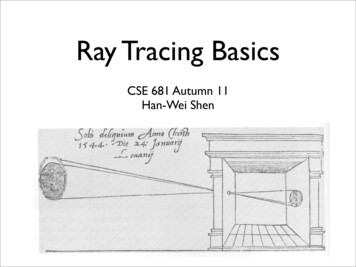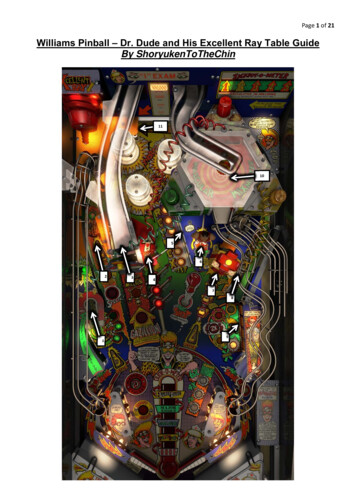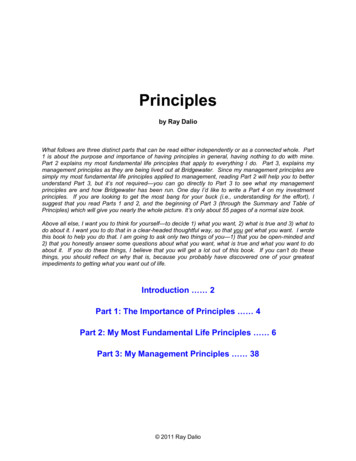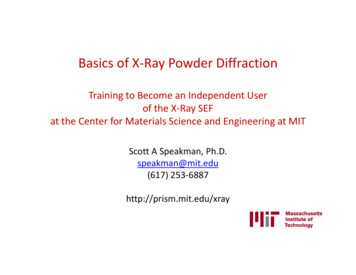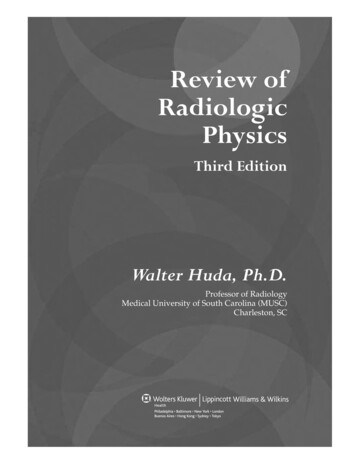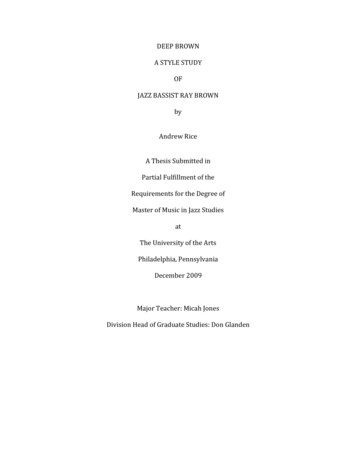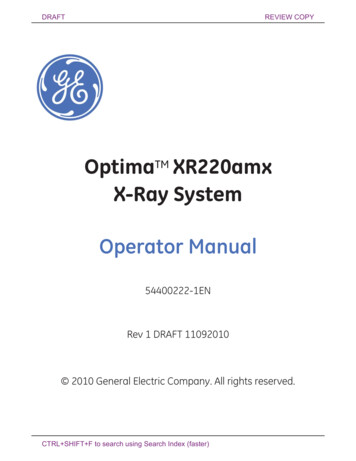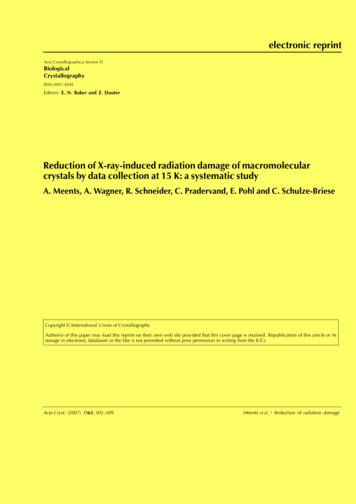
Transcription
electronic reprintActa Crystallographica Section DBiologicalCrystallographyISSN 0907-4449Editors: E. N. Baker and Z. DauterReduction of X-ray-induced radiation damage of macromolecularcrystals by data collection at 15 K: a systematic studyA. Meents, A. Wagner, R. Schneider, C. Pradervand, E. Pohl and C. Schulze-BrieseCopyright International Union of CrystallographyAuthor(s) of this paper may load this reprint on their own web site provided that this cover page is retained. Republication of this article or itsstorage in electronic databases or the like is not permitted without prior permission in writing from the IUCr.Acta Cryst. (2007). D63, 302–309Meents et al. Reduction of radiation damage
research papersActa Crystallographica Section DBiologicalCrystallographyISSN 0907-4449A. Meents,a*‡ A. Wagner,b*‡R. Schneider,a C. Pradervand,aE. Pohla and C. Schulze-BrieseaaPaul Scherrer Institut, Swiss Light Source,CH-5232 Villigen, Switzerland, and bDiamondLight Source Ltd, Chilton, Didcot OX11 0DE,England‡ These authors contributed equally to thiswork.Correspondence e-mail: tion of X-ray-induced radiation damage ofmacromolecular crystals by data collection at 15 K:a systematic studyThe cryocooling of protein crystals to temperatures of around100 K drastically reduces X-ray-induced radiation damage.The majority of macromolecular data collection is thereforeperformed at 100 K, yielding diffraction data of higherresolution and allowing structure determination from muchsmaller crystals. However, at third-generation synchrotronsources radiation damage at 100 K still limits the useful dataobtainable from a crystal. For data collection at 15 K, realisedby the use of an open-flow helium cryostat, a further reductionof radiation damage is expected. However, no systematicstudies have been undertaken so far. In this present study, atotal of 54 data sets have been collected from holoferritin andinsulin crystals at 15 and 90 K in order to identify the effect ofthe lower data-collection temperature on the radiationdamage. It is shown that data collection at 15 K has only asmall positive effect for insulin crystals, whereas for holoferritin crystals radiation damage is reduced by 23%compared with data collection at 90 K.Received 4 September 2006Accepted 8 December 20061. Introduction# 2007 International Union of CrystallographyPrinted in Denmark – all rights ular crystallography beamlines at third-generation synchrotrons can easily achieve photon fluxes greaterthan 1012 photons s 1, with micro-focusing optics allowing thisflux to be delivered on spots of 50 mm2 or smaller. Because ofthis immense flux density and the resulting large absorbeddose, radiation damage has become an important factor insuccessful macromolecular structure determination (Garman& Nave, 2002). The cooling of protein crystals to cryogenictemperatures drastically reduces the rate of damage to thecrystals (Blake & Phillips, 1962; Low et al., 1966). Followingthe introduction of appropriate freezing techniques andcryostats (Haas & Rossmann, 1970; Garman & Schneider,1997; Teng, 1990), data collections are now routinely performed at 90–120 K using open-flow nitrogen cryostats.However, even at temperatures of around 100 K radiationdamage is still a major obstacle to successful structure determination. Especially for systems yielding only small crystals orwith large unit cells, a further mitigation of radiation damagewould therefore be highly desirable.Cryocooling of biological samples to lower temperaturesthan 90 K has been discussed for many years in cryoelectron microscopy. In electron-microscopy studies of twodimensional bacteriorhodopsin crystals, Stark and coworkersfound a ‘cryoprotection factor’ of 1.4 for the low-resolutionshell data (7 Å) and of 2.5 for the high-resolution shell data(2.5 Å; Stark et al., 1996) on decreasing the data-collectiontemperature from 98 to 4 K. However, detrimental effects ofcooling to 12 K compared with 82 K have more recently beenobserved in cryo-electron tomography (Iancu et al., 2006). Theelectronic reprintActa Cryst. (2007). D63, 302–309
research papersauthors postulate that vitreous ice present at 12 K undergoes aphase transition upon electron irradiation, leading to a volumeexpansion and thereby destroying the sample.Open-flow helium cryostats allow data collection attemperatures as low as 5 K without additional scatteringarising from vacuum windows, as is the case with closed-cyclecryostats. Experiments with two d-xylose isomerase crystalsrevealed a longer lifetime of the crystal exposed to an intenseX-ray beam at 17 K compared with that at 100 K (Hanson etal., 2002). In a second study, a weak positive effect of coolingto 40 K was found for hen egg-white lysozyme crystals at highabsorbed doses (Teng & Moffat, 2002).However, to date no systematic studies comparing a largenumber of crystals have been undertaken. It is therefore thegoal of this study to systematically investigate the effect ofcryocooling to 15 K on radiation damage to protein crystals.Therefore, additional parameters such as initial crystal quality,effects of crystal handling and cryocooling protocol and datacollection parameters have been minimized. Furthermore, acontrol experiment at 90 K using an identical experimentalsetup was performed (with the exception of using an N2crysotat instead of a He cryostat). The comparison of a largenumber of crystals should lead to statistically reliable results.Table 1Summary of insulin and ferritin data-collection parameters at beamlineX10SA at the Swiss Light Source (SLS).The photon flux at 13.5 keV was experimentally determined to be 1.8 1012 photons s 1.Oscillation Exposure No. of Dose perCrystal-to-detectorrange ( )time (s)images image (Gy) distance (mm)Insulin 1Ferritin 0.5113602700.74 1053.1 105120140with 3 ml 25%(v/v) ethylene glycol solution in the same buffer.Crystals grew in around one week to 60–100 mm in size.Holoferritin crystals (space group F432; unit-cell parametera ’ 181 Å; molecular weight 19.8 kDa; 64% solvent content)were grown by mixing equal amounts of a 10 mg ml 1 aqueousferritin solution (Fluka, catalogue No. 96701) with a reservoirsolution containing 80 mM CdSO4, 0.8 M (NH4)2SO4 and25%(v/v) glycerol and subsequent equilibration against thisreservoir solution (Ravelli et al., 2002). Crystals with dimensions of 75–125 mm grew within a few days. Insulin and ferritincrystals with average dimensions in the range 80–100 mm werechosen for the experiments.2.2. Beamline setup2. ExperimentalPorcine insulin and horse spleen holoferritin were chosen asmodel systems for a number of reasons. Both proteins can beeasily and reproducibly crystallized, yielding crystals ofcomparable size and quality. Furthermore, they can be crystallized in the cubic crystal system. This facilitates subsequentdata evaluation, since crystal rotations of less than 30 aresufficient to obtain almost complete data sets with sufficientredundancy for significant statistics. Additionally, crystallization conditions containing the cryoprotectant were available for both proteins. This eliminates possible variations incrystal quality arising from additional cryo-handling steps, e.g.slightly different soaking times.A further reason for choosing holoferritin as a modelsystem was its high absorption cross-section. This is mainly aconsequence of its amorphous iron core, which containsaround 1760 Fe atoms (Owen et al., 2006).2.1. CrystallizationThe crystallization of proteins depends on many physicaland chemical parameters such as changes of temperature, pH,protein and precipitate concentration (McPherson, 2002). It isof advantage if the contribution of crystal quality variations tothe X-ray data quality is smaller than the expected effect ofcryocooling from 90 to 15 K. Therefore, only crystals grownunder the same conditions were used for the experiment.Cubic Zn-free insulin crystals (space group I213; unit-cellparameter a ’ 78 Å; molecular weight 5.8 kDa; 65% solventcontent) were grown by batch crystallization by mixing 3 ml15 mg ml 1 porcine insulin (Sigma Aldrich, catalogue No.I-5523) solution in 0.05 M sodium phosphate buffer pH 11Acta Cryst. (2007). D63, 302–309At third-generation synchrotron sources, the beam size isoften smaller than the crystal cross-section. Rotation of thecrystal during data collection causes unexposed and thereforeundamaged crystal material to be continuously introducedinto the beam. Thus, a more or less damaged part and acompletely undamaged part contribute to the diffractionpattern (Schulze-Briese et al., 2005). This dramaticallycomplicates subsequent analysis of radiation-damage effects.To eliminate these volume effects and to expose the wholecrystal in the vertical direction perpendicular to the rotationaxis, the beam was vertically defocused to a size of 200 80 mm (vertical horizontal). The beamsize was adjusted byviewing a cerium-doped YAG screen with a video camera.This ensured that all crystals were bathed in the beam in avertical direction (perpendicular to the rotation axis) duringthe experiments.Data collection at 15 K was performed using an open-flowhelium cryostat (HeliJet) from Oxford Diffraction. Prior toprotein data collection, the temperature of the device wascalibrated with a Si diode (Lakeshore DT-421-HR) at bothroom temperature and 10 K. Additionally, the cubic to hexagonal phase transition of Ni(NH3)6I2 occurring at around19.7 K was used to validate the temperature calibration fromdiffraction images (Eckert & Press, 1980). The HeliJetconsumed around 2 l of liquid helium per hour when operatedat 15 K during the experiments, which corresponds to agas-flow rate of 25 l min 1 (for the inner and outer shieldtogether). The corresponding data collections at 90 K wererealised using a standard open-flow nitrogen cryostat(CryoJet) from Oxford Instruments. The flow rates wereadjusted to 10 l min 1 each for the inner and outer shield. Tofacilitate crystal centring, especially when using the HeliJet, anelectronic reprintMeents et al. Reduction of radiation damage303
research papersTable 2Summary of insulin data-set statistics at 15 and 90 K.The first value in each cell is the average value over all data sets. The following values in parentheses are the lowest and highest values found within thecorresponding group.hI/ (I)ihRsymihCompletenessihRedundancyihI/ (I)i, 1.5–2.0 ÅhRsymi, 1.5–2.0 ÅhCompletenessi, 1.5–2.0 ÅhRedundancyi, 1.5–2.0 ÅWilson B factor (Å2)Lattice spacing (Å)Mosaicity ( )Total dose (MGy)Insulin, 15 K(first data sets)Insulin, 15 K(last data sets)Insulin, 90 K(first data sets)Insulin, 90 K(last data sets)16.18 (12.26, 19.99)5.6 (4.3, 8.9)93.3 (88.8, 97.0)3.7 (3.6, 3.9)9.87 (5.32, 13.31)12.5 (7.9, 24.5)95.4 (88.1, 99.3)3.8 (3.7, 4.1)15.1 (11.9, 16.8)77.33 (77.14, 77.48)0.20 (0.12, 0.26)2.211.97 (9.37, 14.59)6.5 (5.1, 9.8)92.6 (86.7, 94.9)3.6 (3.0, 3.9)4.35 (1.95, 7.11)35.3 (14.2, 70.8)91.0 (83.7, 97.1)3.8 (2.9, 4.1)22.2 (19.9, 24.3)77.62 (77.47, 77.78)0.21 (0.11, 0.30)26.617.81 (14.68, 21.11)4.9 (4.2, 5.6)93.5 (85.9, 96.8)3.8 (3.7, 3.9)11.35 (6.70, 17.57)10.5 (5.5, 18.2)96.4 (92.7, 99.0)3.7 (3.6, 3.9)15.2 (12.8, 16.4)77.43 (77.34, 77.57)0.14 (0.09, 0.17)2.213.50 (9.15, 18.18)5.5 (4.1, 6.8)92.5 (88.6, 94.0)3.6 (2.8, 3.8)4.33 (2.16, 7.88)35.5 (14.6, 64.8)90.4 (84.8, 96.0)3.8 (2.9, 4.1)22.4 (20.5, 23.6)77.62 (77.47, 77.75)0.16 (0.10, 0.29)26.6on-axis viewing system was installed at the beamline. Allcrystals were flash-cooled by moving them quickly into thecold stream of the corresponding cryostat.2.3. Diffraction experimentDiffraction experiments were carried out at the macromolecular crystallography beamline X10SA of the Swiss LightSource (SLS) at Paul Scherrer Institut, Villigen, Switzerland(Pohl et al., 2006). All X-ray diffraction data were collected ata photon energy of 13.5 keV. A rotation increment of 1 waschosen for insulin and of 0.5 for holoferritin owing to itslarger unit-cell parameters. Data-collection parameters forboth the insulin and ferritin crystals are summarized in Table1. All experiments were performed without any changes ofbeamline parameters, thereby guaranteeing the same datacollection conditions for all crystals, apart from the datacollection temperature. The SLS storage ring is routinelyoperated in TOPUP mode with beam-intensity variations ofless than 0.5%, thus no corrections for the ring-induced decayof the primary beam intensity were required. The incidentphoton flux was monitored by using a PIN diode and the beamposition was monitored using a CVD diamond quadrantbeam-position monitor (Schulze-Briese et al., 2001). Nochanges of flux or position were observed over the 72 h of theexperiments. All data were collected with the same exposuretime of 1 s per rotation increment. This procedure yields acontinuous series of images and excludes any possible doserate effects on radiation damage (Leiros et al., 2006; Ravelli etal., 2003). The disadvantages of this approach are longer datacollection times per crystal for the same total dose and moresaturated (low-order) reflections.Data sets were collected from 26 insulin crystals and 28ferritin crystals; for each crystal type, half of these data setswere collected at 15 K and half at 90 K.2.4. Data processingThe diffraction images were subsequently processed usingthe program package XDS (Kabsch, 2001) in two differentways. Data were integrated in 30 wedges for the insulin304Meents et al. Reduction of radiation damagecrystals and in 15 wedges for the ferritin crystals. With totalcrystal rotations of 360 for insulin crystals and 135 forferritin crystals, 12 consecutive data sets were obtained forevery insulin crystal and nine consecutive data sets for everyferritin crystal. A total of 564 independently processed datasets were thus obtained. Only one of these data sets could notbe used for further analysis owing to several blank imagescaused by shutter-synchronization errors. All insulin andferritin data were processed and scaled in the same way. Forhigh-resolution data ( 2.0 Å), statistics were calculated inshells of 0.1 Å width. From these shells, the outermost shellwith an average I/ (I) ratio of 6 was determined from thefirst wedge of data from each crystal. Statistical quality indicators such as the I/ (I) ratios or the Rsym values from thisresolution shell were used throughout the paper to monitorradiation damage-induced decay in subsequent rotationwedges. As radiation-induced decay of diffraction properties,rather than the initial diffraction quality, is of primary interest,normalized data-quality indicators were calculated foranalysis. These normalized parameters were obtained bydividing the data-quality indicators of the subsequent wedgesby their values from the first wedge. The standard deviationsshown as error bars in Figs. 2–5 are based on the scatter ofthese normalized parameters within each group. All data-setstatistics were calculated with XSCALE. The resolution limitis defined as the resolution shell still providing a completenessof 50% at I/ (I) 2 (Sheldrick et al., 1993).In order to determine the unit-cell parameter more accurately, all data were reprocessed keeping the crystal-todetector distance fixed, as data from the initial processingshowed a significant shift in the crystal-to-detector distance.To obtain an indicator for the absolute crystal quality, all datawere additionally scaled with a high-resolution limit of 1.5 Åfor insulin and 1.8 Å for ferritin. To indicate the quality of thehigh-resolution data, a resolution shell of 1.5–2.0 Å (insulin)and 1.8–2.3 Å (ferritin) was chosen. Tables 2 and 3 giveaverage and extreme absolute values for the first and last datawedge for several quality indicators.Dose calculations were performed with the programRADDOSE (Murray et al., 2004). Additionally, for the doseelectronic reprintActa Cryst. (2007). D63, 302–309
research papersTable 3Summary of ferritin data-set statistics at 15 and 90 K.The first value in each cell is the average value over all data sets. The following values in parentheses are the lowest and highest values found within thecorresponding group.hI/ (I)ihRsymihCompletenessihRedundancyihI/ (I)i, 1.8–2.3 ÅhRsymi, 1.8–2.3 ÅhCompletenessi, 1.8–2.3 ÅhRedundancyi, 1.8–2.3 ÅWilson B factor (Å2)Lattice spacing (Å)Mosaicity ( )Total dose (MGy)Ferritin, 15 K(first data sets)Ferritin, 15 K(last data sets)Ferritin, 90 K(first data sets)Ferritin, 90 K(last data sets)15.32 (10.26, 20.65)6.0 (4.4, 7.8)84.9 (64.0, 95.2)3.9 (3.1, 5.1)7.10 (3.75, 12.28)12.5 (5.8, 23.3)82.2 (63.4, 91.8)4.1 (3.2, 5.5)20.2 (16.6, 24.5)180.18 (179.79, 180.44)0.19 (0.13, 0.27)9.311.46 (8.28, 16.73)7.8 (5.1, 10.8)89.9 (79.8, 95.2)3.8 (2.9, 4.1)4.04 (2.14, 6.90)23.4 (11.9, 43.1)84.6 (75.7, 91.1)4.1 (3.8, 5.2)27.9 (24.5, 31.8)180.86 (180.51, 181.27)0.18 (0.12, 0.29)83.721.76 (17.58, 26.00)5.2 (3.4, 19.9)90.9 (75.9, 96.4)3.7 (3.5, 4.5)12.43 (8.73, 16.97)6.4 (3.6, 10.3)88.3 (79.1, 93.8)3.9 (3.6, 4.7)16.4 (14.9, 18.3)180.48 (180.13, 180.71)0.12 (0.08, 0.22)9.316.44 (12.30, 21.13)6.5 (4.0, 24.5)90.2 (77.1, 94.9)3.8 (3.6, 4.4)6.40 (3.60, 10.25)14.3 (7.1, 24.5)85.5 (76.7, 92.7)4.1 (3.7, 4.8)25.8 (21.7, 34.8)181.03 (180.82, 181.58)0.13 (0.09, 0.19)83.7calculations of holoferritin, the core of 1760 Fe atoms per 24protein subunits was included as recently determined bymicroPIXE (Owen et al., 2006).3. ResultsRadiation damage in macromolecular crystals manifests itselfin different ways. Most obvious to the experimentalist is theloss of diffraction power of the crystal. This degradation canbe easily analyzed in a quantitative way by following the decayof various parameters. In particular, the decay of the relativeI/ (I) values, the increase in Rsym and the decay of the resolution limit were used as diffraction data-quality indicators inorder to follow radiation damage. In addition, changes in boththe unit-cell parameter and the crystal mosaicity wereanalyzed. In addition to changes in the global diffractionquality, X-rays induce specific structural changes at certainspecific sites (Weik et al., 2000; Ravelli & McSweeney, 2000;Burmeister, 2000). The analysis of specific radiation damage atthe two different data-collection temperatures is beyond thescope of this paper and will be discussed in a forthcomingpaper.3.1. Decay of diffracting powerFig. 1 shows the decay of I/ (I) for the I/ (I) 6 shell asfunction of the absorbed dose for all measured crystals. Fig. 2shows a plot of the averaged normalized I/ (I) as a function ofthe absorbed dose for the two different data-collectiontemperatures. In order to allow a quantitative comparison, alinear function was fitted to both the ferritin and insulin data.The slope of the 15 K data sets is significantly smaller than forthe 90 K data in the case of ferritin, whereas for insulin only asmall difference is found. The slopes of the fit function show asmall reduction of the I/ (I) decay of 6% in the case of insulin( 0.0218 0.0005 versus 0.0231 0.0008 MGy 1; accumulated dose 26.64 MGy) and a significant reduction of 23%for holoferritin ( 0.0056 0.0001 versus 0.0073 0.0002 MGy 1; accumulated dose 83.7 MGy). The absoluteoverall values of I/ (I) show a small difference in the startingActa Cryst. (2007). D63, 302–309values of the 15 and 90 K data sets for the insulin crystals: 16.2 2.0 at 15 K and 17.81 2.0 at 90 K. The initial I/ (I) ratiosfor the ferritin crystals are 15.3 3.0 for the 15 K data and21.8 2.5 for the 90 K data. These unexpected differences areprobably a result of the flash-cooling protocol and will bediscussed later.In addition to the differing behaviour of the two proteinswith respect to the reduction of radiation damage whenlowering the data-collection temperature, insulin and ferritinalso differ drastically in their total susceptibility to radiationdamage. In the case of insulin I/ (I) is reduced to 50% of itsinitial value in the outermost resolution shells, providing anI/ (I) 6 after an absorbed dose of 22 MGy (90 K) and24 MGy (15 K), whereas for ferritin the same reduction isobserved only after a dose of 77 MGy (90 K) and can beextrapolated to 99 MGy for 15 K, respectively.Other overall data-quality parameters such as the Rsymvalues and the resolution limit follow the same trend as I/ (I).The increase of the relative Rsym values with dose is shown inFig. 3. A positive effect of cryocooling to 15 K can clearly beseen in both cases. As already observed for the I/ (I), thispositive effect is more pronounced in the case of ferritin. Theaveraged absolute Rsym value for the insulin crystals increasesfrom 19.1 2.7% to 46.0 4.6% for the 15 K data and from19.5 1.8 to 50.9 3.6% for the 90 K data. For ferritin anincrease from 20.7 1.6% to 38.3 4.4% at 15 K and from18.5 2.0% to 45.2 6.1% at 90 K is observed.Fig. 4 shows the absolute decrease of the averaged resolution limits for insulin and ferritin at the two differenttemperatures as a function of absorbed dose. The insulincrystals at 15 and 90 K start with almost the same averageresolution limit: 1.35 0.06 and 1.36 0.09 Å, respectively.These values decrease to 1.58 0.13 Å at 15 K and to 1.61 0.11 Å at 90 K in the last wedge. Thus, only a small reductionin radiation damage-induced decay is observed in the resolution limit for insulin. For the ferritin crystals the initial resolution limit for the 15 K crystal (1.78 0.19 Å) is almost 0.3 Ålower than for the 90 K crystals (1.50 0.09 Å). During doseaccumulation, the resolution limit decreases by 0.17 Å to 1.95 0.14 Å at 15 K and by 0.31 Å to a final value of 1.81 electronic reprintMeents et al. Reduction of radiation damage305
research papers0.10 Å at 90 K. As previously mentioned, the differences inthe initial crystal quality are probably a consequence of thedifferent gases and temperature gradients used for flashcooling. However, for the 15 K data a much slower decrease ofthe resolution limit with dose is observed, indicating a reduceddamage rate compared with the 90 K data, as alreadyobserved for the I/ (I) ratio and the Rsym values.3.2. Crystal mosaicityAn increase in the crystal mosaicity arising from radiationdamage has been previously observed in protein crystals(Ravelli et al., 2002; Ravelli & McSweeney, 2000). However, inthe present study no significant changes could be found.Insulin crystals flash-frozen at 15 and 90 K show averagemosaicities of 0.20 0.04 and 0.14 0.03 in the first wedge,increasing to 0.21 0.05 and 0.16 0.05 , respectively. Theaverage mosaicity of ferritin crystals at 15 K is 0.19 0.04 inthe first wedge, decreasing to 0.18 0.05 in the last wedge,and increasing from 0.12 0.04 to 0.13 0.03 at 90 K. Morenotable than the mosaicity changes with X-ray dose are thedifferences between the two temperatures. In both cases,crystals flash-cooled in the 15 K helium gas stream showsignificantly higher mosaicity than crystals flash-frozen at90 K.The crystal mosaicities were taken from XDS data processing. It should be noted that the mosaicity parameters determined by XDS, or any other integration program, are not onlysensitive to the crystal mosaicity itself, but are also affected byseveral other parameters. However, by using the sameexperimental conditions, the only variable is the crystalmosaicity. Therefore, these values should be considered as arelative measure rather than describing the ‘real’ crystalmosaicity, defined as the angular misalignment of the differentmosaic blocks. The mosaicity values given should be wellsuited for indicating relative differences in the crystal quality.3.3. Lattice parametersFigure 1Decay of the absolute I/ (I) (see x2.4 for definition) for all insulin andferritin crystals at 15 and 90 K plotted as a function of the absorbed dose.In several previous studies, changes in the lattice parameters have been used to follow radiation damage (Müller etal., 2002; Ravelli et al., 2002). As expected, in the present studyboth proteins show smaller average starting lattice parametersat 15 K compared with at 90 K owing to reduced thermalmotion. Insulin crystals show an average lattice parameter of77.33 0.10 Å at 15 K and 77.43 0.06 Å at 90 K in the firstwedge. These increase to values of 77.62 0.10 Å at 15 K and77.61 0.08 Å at 90 K in the last wedge. The same trend isobserved for ferritin: the averaged lattice parameters at 15 Kare 180.2 0.2 Å and 180.5 0.2 Å at 90 K in the first wedge,increasing to 180.9 0.2 Å (15 K) and 181.1 0.2 Å (90 K) inthe last wedge. Fig. 5 shows the relative increase of the latticeparameters for insulin and ferritin crystals as a function ofFigure 2Decay of the normalized average I/ (I) (see x2.4 for definition) for insulinand ferritin crystals at 15 and 90 K plotted as a function of the absorbeddose. The corresponding linear-fit parameters for the graphs are given inthe text.306Meents et al. Reduction of radiation damageFigure 3Average increase of the normalized Rsym for insulin and ferritin crystalsmeasured at 15 and 90 K with dose. For both systems, an exponentialgrowth of the Rsym values can be observed.electronic reprintActa Cryst. (2007). D63, 302–309
research papersaccumulated dose at the two different temperatures. Interestingly, in both cases a greater increase in the lattice parameters is observed at lower temperatures. In the case ofinsulin, the averaged lattice parameter at 15 K even attains ahigher absolute value compared with the 90 K data in the lastwedge.4. DiscussionThe analysis of I/ (I) ratios, Rsym values and resolution limits(Figs. 1–5) give a very consistent picture for the two proteinsunder study. For both insulin and holoferritin, a reduction ofradiation damage at 15 K in comparison to 90 K is observed.Interestingly, the two model systems show different behaviourin the extent of this reduction. For insulin, the differences inthe relative decay of I/ (I) at the two different temperaturesare small (around 6%). Holoferritin presents a differentpicture: the reduction is much more pronounced and thedifference in the decay of I/ (I) reaches 23%. The reason forthis reduced radiation-damage rate is probably the slowerdiffusion of electrons and electron holes at lower temperatures. An explanation of the differences in the reduction ofradiation damage between insulin and ferritin crystals mightinvolve the pH-dependency of radiation chemistry; insulin wascrystallized at pH 11 and ferritin at a pH of 7.4.1. Crystal mosaicityIn addition to this reduced damage rate at 15 K comparedwith 90 K, ferritin crystals measured at 15 K clearly showedpoorer initial diffraction properties. Differences in the initialabsolute crystal-quality parameters such as I/ (I), Rsym valuesand resolution limit are probably the result of using differentgases at different temperatures for flash-cooling (Kriminski etal., 2003). It is well documented that the flash-cooling ofprotein crystals induces strain and stress within crystals,resulting in a higher crystal mosaicity compared with crystalsat room temperature (Lovelace et al., 2006). The strain andstress induced in the crystal would be more severe for highertemperature gradients. Therefore, one would expect a highermosaicity for crystals flash-frozen in a 15 K helium streamcompared with those flash-cooled to 90 K in gaseous nitrogen.This hypothesis is supported by the observation that insulinand ferritin crystals flash-cooled in the helium stream show asignificantly higher mosaicity than crystals flash-cooled to90 K. Insulin crystals flash-frozen to 15 K showed an averagemosaicity that was 43% higher compared with those flashcooled at 90 K. For ferritin a 38% higher mosacity wasobserved at 15 K. For the ferritin crystals at least, these highermosaicity crystals at 15 K show poorer diffraction propertiesin terms of I/ (I) and Rsym compared with the 90 K crystals(Fig. 1, Table 3). This relation is also found for the insulin data,but is considerably less pronounced (Fig. 1, Table 2).4.2. Sample vibrationsAnother possible explanation of the differences in the dataquality at 15 and 90 K could be sample vibrations induced byturbulence from the different cryostreams. Especially atprotein crystallography undulator beamlines at third-generation synchrotron sources, which provide a very brilliant X-raybeam, such sample vibrations can result in poor data quality(Flot et al., 2006). If the helium stream induces more samplevibrations than the nitrogen stream, then the quality of bothlow-resolution and high-resolution reflections should beaffected, resulting in a decrease of I/ (I) and an increase in Rvalues. In the present study, insulin and ferritin crystalsmeasured at 15 and 90 K show comparable R values in thelow-resolution shells. This indicates that the lower I/ (I)observed at 15 K is not a result of sample vibrations in thehelium stream.Figure 4Figure 5Decrease of the average resolution limit for insulin and ferritin crystalsmeasured at 15 and 90 K with dose. The resolution limit is defined as theresolution shell that still provides a completeness of 50% at I/ (I) 2.Averaged changes of the normalized unit-cell parameters of insulin andferritin crystals at the two different data-collection temperatures of 15and 90 K as a function of dose.Acta Cryst. (2007). D63, 302–309electronic reprintMeents et al. Reduction of radiation damage307
research papers4.3. Lattice parametersFor both insulin and ferritin, an increase in the latticeparameter is observed as a function of dose. However, asalready mentioned above, the magnitude of the increasesurprisingly differs significantly at the two temperatures. At15 K both systems show a significantly larger increase of theirnormalized lattice parameters compared with the crystals at90 K. A possible explanation for this may be related to the gaswhich is generated as a result of irradiation w
pattern (Schulze-Briese et al., 2005). This dramatically complicates subsequent analysis of radiation-damage effects. To eliminate these volume effects and to expose the whole crystal in the vertical direction perpendicular to the rotation axis, the beam was vertically defocused to a size
